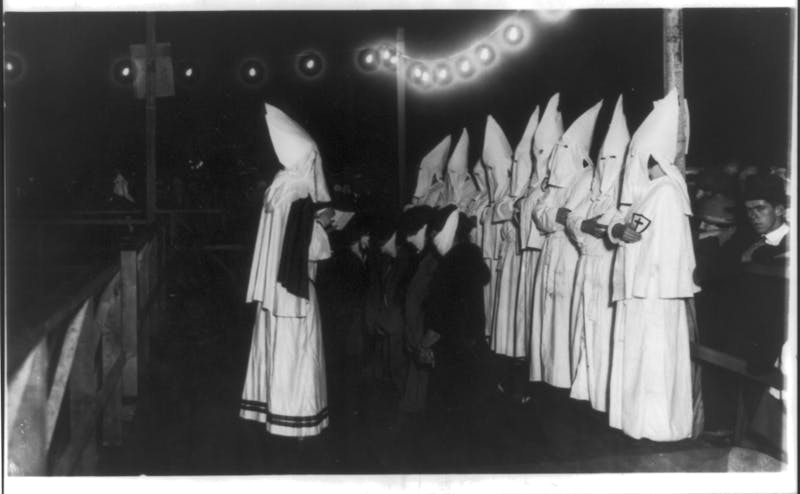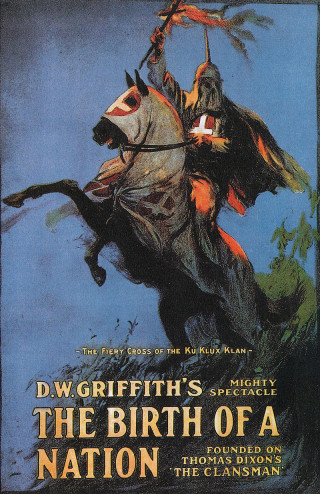
The Library of Congress
It was in this context of bald-faced violence and injustice that Thomas Dixon recirculated the myth of the black rapist, pursued by vengeful robed vigilantes, for his 1905 novel and play, The Clansman. For the first edition of the book, the president of the Society of Illustrators, Arthur I. Keller, depicted the Reconstruction-era Klansmen in an anachronistic uniform of white, shoulder-length, face-concealing hoods beneath spiked caps. Dixon’s theater costumes adapted Keller’s book illustrations and added a conical white hat to the mix. Together they reintroduced pantomime, fantasy, and nostalgia to what had become a horribly commonplace spectacle for white crowds of murderers.
Then Hollywood took charge. In 1915, director D. W. Griffith adapted The Clansman as The Birth of a Nation, one of the very first feature-length films and the first to screen in the White House. Its most famous scene, the ride of the Klan, required 25,000 yards of white muslin to realize the Keller/Dixon costume ideas. Among the variety of Klansman costumes in the film, there appeared a new one: the one-piece, full-face-masking, pointed white hood with eyeholes, which would come to represent the modern Klan. Maybe it was Griffith who brought those pieces of fabric together in their soon-to-be iconic form; after all, his mother had sewn costumes for his Klansman father. Or, given the heterogeneity of Reconstruction Klan costumes, maybe Griffith got the idea from another source altogether: Freemason regalia. Or maybe it wasn’t Griffith’s idea at all, but that of Paris-trained, Costume Designer Guild’s Hall-of-Famer Clare West, who worked on the film: maybe she had witnessed confraternal processions in the streets of Europe, or just made it up.
What we do know is that the blockbuster popularity of The Birth of a Nation gave free advertising to a traveling fraternal order organizer, former Methodist minister, and garter salesman, William J. Simmons. Simmons didn’t just organize fraternities; he’d joined fifteen of them, including the Knights Templar and the Masons. The 1915 lynching of Leo Frank had inspired Simmons to form a new anti-Semitic, nativist fraternity. One week before The Birth of a Nation’s Atlanta premiere, Simmons received his state charter for “The Invisible Empire, Knights of the Ku Klux Klan, Incorporated.” He sold hoods and robes ($6.50) sewn in a local shop, wrote a handbook—the Kloran—and, in 1920, hired publicists Edward Y. Clarke and Elizabeth Tyler to launch a massive campaign that attracted 100,000 new members in 16 months. Kleagles, or recruiters, arranged minstrel shows and screenings of The Birth of a Nation and other pro-Klan films.
